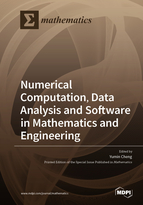Numerical Computation, Data Analysis and Software in Mathematics and Engineering
A special issue of Mathematics (ISSN 2227-7390). This special issue belongs to the section "Engineering Mathematics".
Deadline for manuscript submissions: closed (9 October 2021) | Viewed by 32073
Special Issue Editor
Interests: numerical analysis; applied mathematics; computational mathematics; computational mechanics; civil and structural engineering; CAE software
Special Issues, Collections and Topics in MDPI journals
Special Issue Information
Dear Colleagues,
Dr. Yumin Cheng is Professor of the Shanghai Institute of Applied Mathematics and Mechanics of Shanghai University. He received his bachelor’s degree of mathematics from Shanxi University of China, and PhD degree of computational mechanics from Xi’an Jiaotong University of China. His research interests include the meshless method, boundary element method, and scientific and engineering computing. He has published more than 180 journal papers with 4600 citations. His h-index in scopus.com is 44. He has been honored with Fellow of The International Association of Applied Mechanics (IAAM), Fellow of International Association of Advanced materials and VEBLEO Fellow awards. He is an Executive Committee member of IAAM and Chairman of Committee of IAAM Standards and Codes. He has been Lead Guest Editor of the Special Issue of Mathematical Problems in Engineering (SI: Mathematical Aspects of Meshless Methods; SI: New Trends in Numerical Simulation and Data Analysis), and he is Associate Editor of the International Journal of Computers, Editor and Member of the Editorial Board of the International Journal of Applied Mechanics, and Member of the Editorial Board of the International Journal of Computational Materials Science and Engineering, Journal of Computational Engineering, International Journal of Applied & Experimental Mathematics, and International Journal of Mathematical Physics and Video Proceedings of Advanced Materials.
Based on numerical methods such as the finite element method, boundary element method, and meshless method, numerical simulations for various problems in science, engineering, and society fields have developed rapidly in the recent decades. Various numerical methods are presented for solving problems in different fields, and the corresponding computational efficiency, accuracy, and convergence are studied as well. With the development of big data, numerical simulation combined data analysis will play a more important role in studying problems in the science, engineering, and society fields.
In this Special Issue, we particularly take an interest in manuscripts that report the relevance of numerical computation and data analysis for mathematical and engineering problems. The Special Issue will become an international forum for researchers to summarize the most recent developments of numerical simulations and data analysis within the last five years, especially for new problems. Moreover, manuscripts on the mathematical theories of numerical computation and data analysis for complicated science, engineering or social problems are welcome. We also concern the development of the corresponding aspects based on big data, including the corresponding theory, numerical method, and applications.
Software is an important part of numerical computation and data analysis in mathematics and engineering. This Special Issue also concerns the developments of the software of numerical methods, including the finite element method, boundary element method, and meshless method, and the ones for data analysis.
Prof. Dr. Yumin Cheng
Guest Editor
Manuscript Submission Information
Manuscripts should be submitted online at www.mdpi.com by registering and logging in to this website. Once you are registered, click here to go to the submission form. Manuscripts can be submitted until the deadline. All submissions that pass pre-check are peer-reviewed. Accepted papers will be published continuously in the journal (as soon as accepted) and will be listed together on the special issue website. Research articles, review articles as well as short communications are invited. For planned papers, a title and short abstract (about 100 words) can be sent to the Editorial Office for announcement on this website.
Submitted manuscripts should not have been published previously, nor be under consideration for publication elsewhere (except conference proceedings papers). All manuscripts are thoroughly refereed through a single-blind peer-review process. A guide for authors and other relevant information for submission of manuscripts is available on the Instructions for Authors page. Mathematics is an international peer-reviewed open access semimonthly journal published by MDPI.
Please visit the Instructions for Authors page before submitting a manuscript. The Article Processing Charge (APC) for publication in this open access journal is 2600 CHF (Swiss Francs). Submitted papers should be well formatted and use good English. Authors may use MDPI's English editing service prior to publication or during author revisions.
Keywords
- Numerical method
- Numerical simulation
- Finite element method
- Boundary element method
- Meshless method
- Mathematical model
- Data analysis
- Software
Benefits of Publishing in a Special Issue
- Ease of navigation: Grouping papers by topic helps scholars navigate broad scope journals more efficiently.
- Greater discoverability: Special Issues support the reach and impact of scientific research. Articles in Special Issues are more discoverable and cited more frequently.
- Expansion of research network: Special Issues facilitate connections among authors, fostering scientific collaborations.
- External promotion: Articles in Special Issues are often promoted through the journal's social media, increasing their visibility.
- e-Book format: Special Issues with more than 10 articles can be published as dedicated e-books, ensuring wide and rapid dissemination.
Further information on MDPI's Special Issue polices can be found here.






